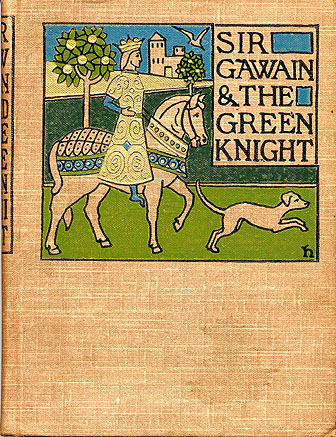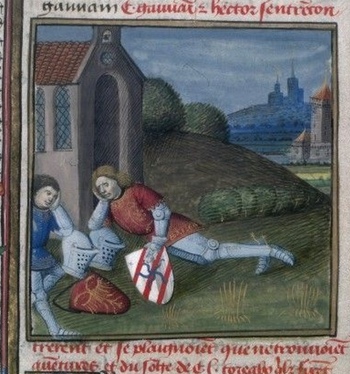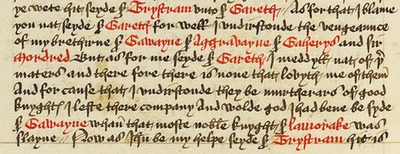Sir Gawain
Siân Echard, University of British Columbia
Detail from BL Royal MS 14.E.iii, fol. 125r, by permission of the British Library. Click the thumbnail to see more from images from this manuscript.
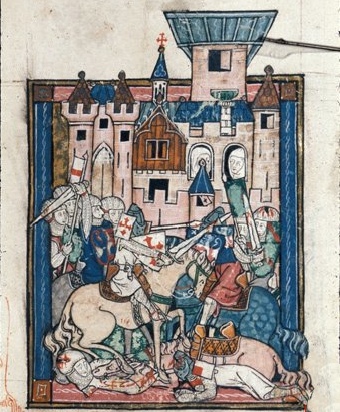
Sir Gawain is a figure who wears many faces in the Arthurian tradition. In the English tradition, he appears prominently first in Geoffrey of Monmouth’s Historia regum Britannie (c. 1138) as Arthur’s nephew. He is a fierce warrior:
When they learned of the death of their men, Hoel and Gawain, warriors than whom no better had ever been born, pressed forward even more fiercely. One went this way, one went that, each riding to attack the emperor’s column first here, then there. Gawain, burning with inexhaustible heroism, did all he could to encounter with Lucius, for he was the most audacious of knights; rushing the enemy, he cast them down, and having cast them down, killed them.
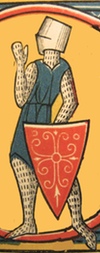 In the anonymous Latin romance De Ortu Waluuanii (The Rise of Gawain ) (12th or 13th century), Gawain’s youth in Rome and his rise to prominence are recounted. Gawain is in this romance a “Fair Unknown,” ignorant of his noble heritage but excelling in all knightly attributes. This romance ends with the heroic Gawain being integrated into the Arthurian court as Arthur’s nephew:
In the anonymous Latin romance De Ortu Waluuanii (The Rise of Gawain ) (12th or 13th century), Gawain’s youth in Rome and his rise to prominence are recounted. Gawain is in this romance a “Fair Unknown,” ignorant of his noble heritage but excelling in all knightly attributes. This romance ends with the heroic Gawain being integrated into the Arthurian court as Arthur’s nephew:
“When you were a child, you were “Boy without a name,” and from that beginning up to the present, you have been called “the Knight with the Surcoat”; and now you will be valued as “Gawain,” your own name.” And when Arthur had said this, three and four times from the whole court, “Gawain, nephew of King Arthur” was redoubled and repeated.
This early, positive portrait of Gawain gives way, in the French tradition, to an increasing emphasis on the negative characteristics of Gauvain. He could be anything from a rather glib lady’s man, to a hardened murderer. In the French Queste del Sant Graal (c. 1215-1235), for example, Gawain is chastised at the outset by a monk for his dissolute life:
In justice, Sir, were you called a bad and faithless servant. You were not admitted to the order of chivalry to soldier in the devil's cause thenceforward, but in order to serve our Maker, defend Holy Church and render at last to God that treasure which He entrusted to your safekeeping, namely your soul. To this end were you made a knight, and you, Gawain, have abused your knighthood. For you have been henchman to the enemy, forsaking your Maker and living the worst and most dissolute life that ever a knight lived.
This sinful life (and an unwillingness to repent) prevents Gawain from succeeding in the quest. The image to the right is from a 15th-century copy of the Queste. Click the image to go to a full digital fascimile of the manuscript.
Detail from Bibliothèque nationale de France, MS français 116, folio 642r, appears in accordance with the BNF terms of non-commercial use.
... Sir Gawain and his three brethren, Agravain, Gaheris, and Sir Mordred, set upon Sir Lamorak in a privy place, and there they slew his horse. And so they fought with him on foot more than three hours, both before him and behind him; and Sir Mordred gave him his death’s wound behind him at his back, and all tohew him... “Fie upon treason,” said Sir Tristram, “for it killeth my heart to hear this tale.” “So it doth mine,” said Gareth, “brethren as they be mine, I shall never love them, nor draw in their fellowship for that deed...” “That is the more pity," said Dinadan, “for Sir Gawain and his brethren, except you Sir Gareth, haten all the good knights of the Round Table...”
The quotation above comes from the Caxton version of the Morte (X.58) but the point is similar in the Winchester manuscript: click the thumbnail to go to folio 287v. The image from BL Additional 59678 appears by permission of the British Library.
There was also a persistent English tradition in which Gawain retained the heroic character he displays in the work of Geoffrey of Monmouth. In this tradition, he often appeared as Arthur’s right-hand man, and as the chief representative of the court. The Boy’s Percy (1882), whose cover you see at right, is an adaptation for adolescents of Bishop Percy’s Reliques of Ancient English Poetry (1765). This collection included The Marriage of Gawaine, one of several tales in which Gawain weds the Loathly Lady in order to save Arthur’s life.
This is a humorous story, to be sure, but note that in this excerpt from the Middle English poemThe Wedding of Sir Gawain and Dame Ragnelle, Gawain’s superlative knightly qualities are stressed:
“Gramercy, corteys Knyght,” sayd the Lady;
“Of alle erthly knyghtes blyssyd mott thou be,
For now am I worshyppyd.
Thou shalle have me fayre bothe day and nyghte
And evere whyle I lyve as fayre and bryghte;
Therfore be nott grevyd.For I was shapen by nygramancy,
With my stepdame, God have on her mercy,
And by enchauntement;
And shold have bene oderwyse understond
Evyn tylle the best of Englond
Had wedyd me verament.”

You can read The Boy’s Percy at the Internet Archive
You can read The Wedding of Sir Gawain and Dame Ragnelle at the TEAMS website
You can see the whole manuscript of Sir Gawain and the Green Knight, discussed further below, at the Cotton Nero A.x Project site, though at present (September 2016), the linked site seems to be down.


Fyrst he watz funden fautlez in his fyue wyttez,
And efte fayled neuer the freke in his fyue fyngres.
And alle his afyaunce vpon folde watz in the fyue woundes
That Cryst kaght on the croys, as the crede telles;
And quere-so-euer thys mon in melly watz stad,
His thro thoght watz in that, thurgh alle other thyngez,
That alle his fersnes he feng at the fyue joyez
That the hende heuen quene had of hir chylde;
At this cause the knyght comlyche hade
In the more half of his schelde hir ymage depaynted,
That quen he blusched thereto his belde neuer payred.
The fyft fyue that I finde that the frek vsed
Watz fraunchyse and felaghschyp forbe al thyng,
His clannes and his cortaysye croked were neuer,
And pite, that passez alle poyntez, thyse pure fyue
Were harder happed on that hathel then on any other.
Click here to go to the Camelot Project’s collection of medieval Gawain texts. You will find a translation of Sir Gawain there.
The illustration on the left, as well as the representation of the pentangle above, come from Dorothea Braby’s illustrations to the 1952 Golden Cockerel Press edition of Sir Gawain and the Green Knight. You can see more images on my Golden Cockerel Sir Gawain page.
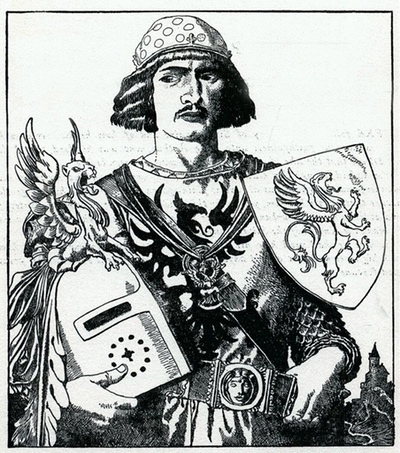
“He was makless on molde, man, by my trewth.
This was Sir Gawain the good, the gladdest of other,
And the graciousest gome that under God lived,
Man hardiest of hand, happiest in armes,
And the hendest in hall under heven-rich,
And the lordliest in leding whiles he live might,
For he was lion alosed in landes ynow;
Had thou knowen him, Sir King, in kithe there he lenged,
His cunning, his knighthood, his kindly workes,
His doing, his doughtiness, his deedes of armes,
Thou wolde have dole for his dede the dayes of thy life.”
The illustration from Howard Pyle, The Story of King Arthur and His Knights (1903) is in the public domain.
